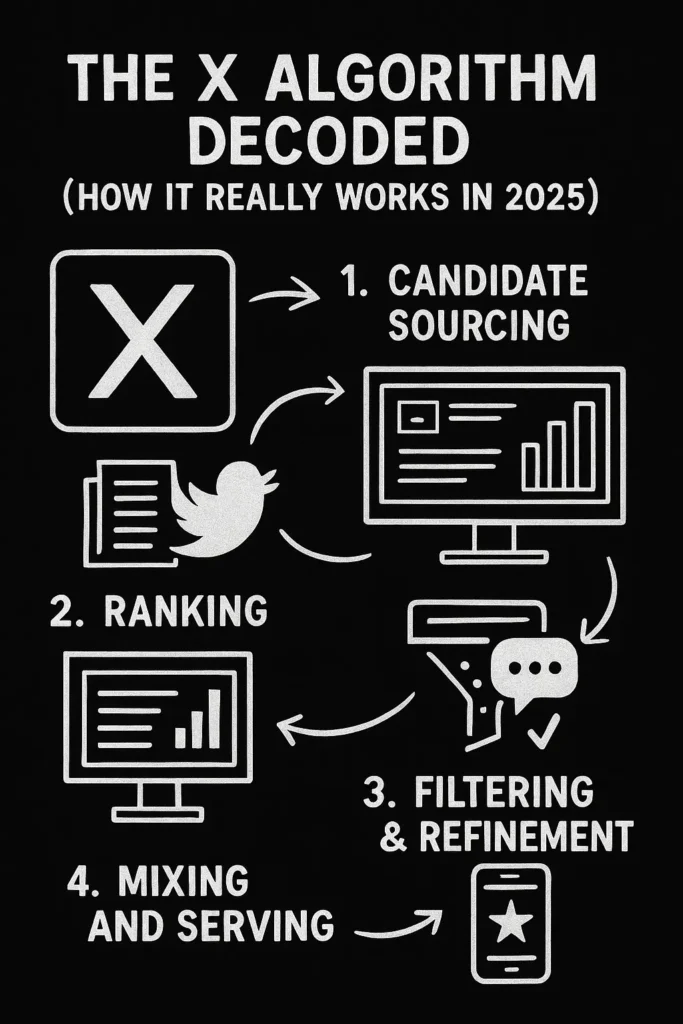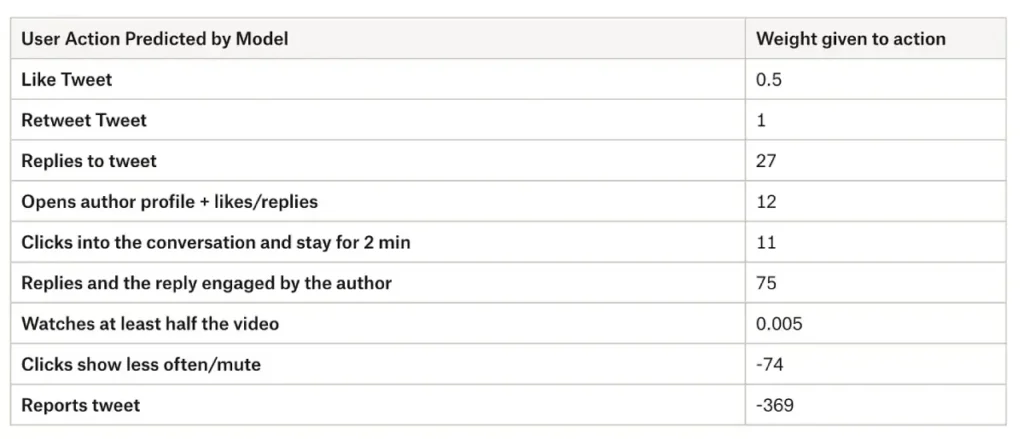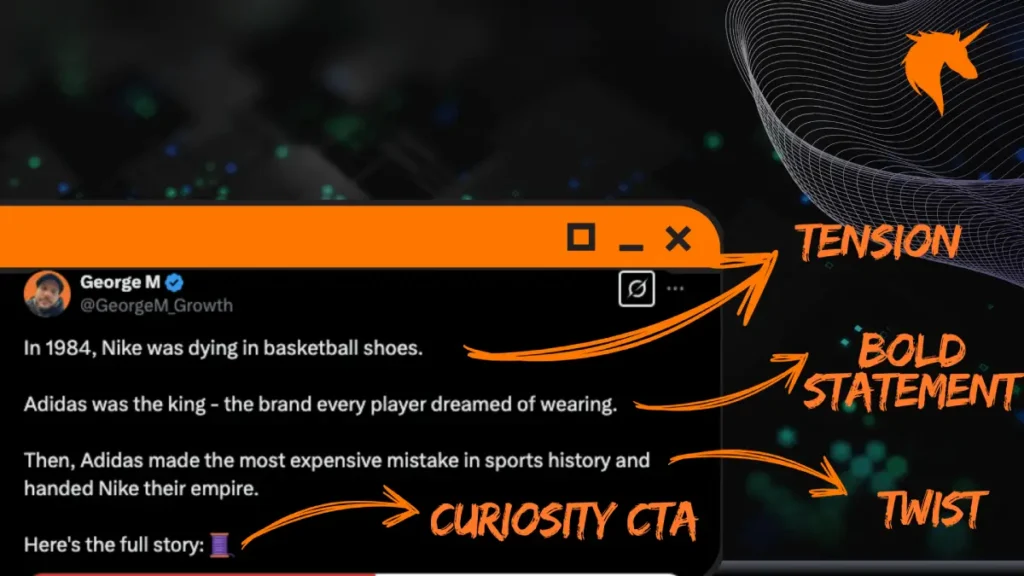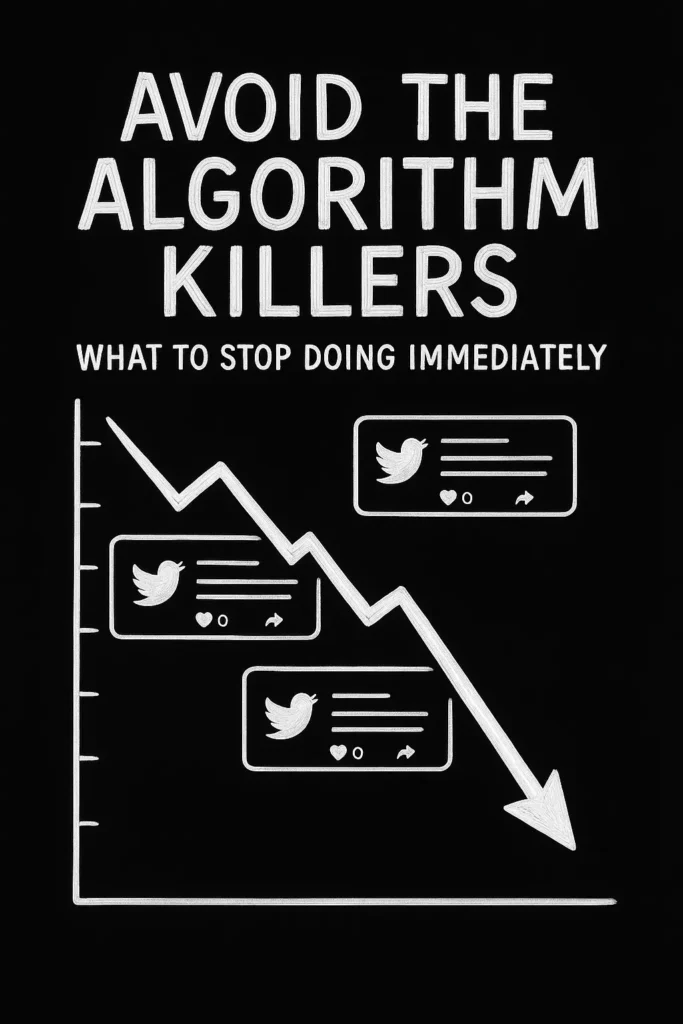
Getting good at Twitter (𝕏) isn’t about luck or waiting for a viral moment. It’s about one thing: understanding the algorithm and working with it.
If you don’t get how it works, you’re playing the game blind.
Elon Musk himself confirmed that Twitter (𝕏) algorithm favors small accounts if they know what they are doing.
A major update to the recommendation algorithm is rolling out over the next few days.
— gorklon rust (@elonmusk) November 10, 2023
This will help surface smaller accounts and posts outside of your friend-follows network.
As always, this will be made open source and undergo continuous improvement.
But here’s the catch: most people fight against the platform’s design.
They post randomly, ignore timing, and never align their strategy with how the algorithm actually functions.
To win, you need to understand what the algorithm wants and build a system to give it exactly that.
- It wants engagement? You prioritize replies and media.
- It wants recency? You post when your target audience is online.
- It wants relevance? You jump on trending topics.
This isn’t theory—it’s how the platform is wired.
In this guide, I’ll show you how the algorithm thinks, what it rewards, and how you can work with it to get good at Twitter in 2025.
Let’s get started.
The X Algorithm Decoded (How it Really Works in 2025)

The only way to get better at Twitter is to understand how their artificial intelligence algorithm works and align your actions with it.
The X algorithm follows a structured process to decide what shows up in your feed.
It’s not about luck—it’s about understanding these four stages:
1. Candidate Sourcing
Every time you open X, the platform pulls around 1,500 potential tweets for your feed. It grabs them from three main sources:
- Accounts you follow – These are the obvious ones, people you chose to engage with.
- Your interactions – Tweets you’ve liked, retweeted, or replied to recently.
- Trending topics – Content that aligns with what you usually engage with.
The more you interact with certain types of content, the more you’ll see it.
2. Ranking
Once X has collected potential tweets, it scores them based on four main factors:
- Engagement Potential: Tweets likely to get replies, retweets, or clicks move up the list.
- Media Presence: Tweets with images, videos, or GIFs are prioritized over plain text.
- Recency: Fresh tweets get a push—X favors what’s happening now.
- Relevance: If a tweet matches your interests, it’s more likely to show up.
The algorithm is designed to reward active participation.
If you’re not sparking engagement, you’re invisible.
3. Filtering & Refinement
This is where the algorithm weeds out the junk:
- Spam and low-quality tweets get cut.
- It checks for diversity, your feed won’t just be one person or topic.
- High-engagement tweets get boosted, while empty noise gets filtered out.
4. Mixing and Serving
The final step is delivering this curated mix to your feed, blending top-ranked tweets, ads, and trending topics—all in under 1.5 seconds.
How to Align Your Strategy with the Algorithm’s Priorities
Prioritize Engagement (Replies > Likes)

Twitter (𝕏) is a social media platform, and that means its core function is interaction.
The more you engage, the more you’re rewarded.
But not all engagements are created equal.
Most people obsess over likes and retweets, but the real power lies in replies, as you can see in the image above.
Why Replies Matter More Than Likes:
Replies are weighted 27x more than likes by the algorithm.
When you reply to a tweet, it signals real interaction, not just a passive acknowledgment.
This boosts visibility in the feed and tells the algorithm your content is part of an active conversation.
The best part?
Replies often create loops. If your reply sparks interest, it triggers more replies, which keeps the thread alive longer and drives even more impressions.
Think about it: a like is a dead-end. A reply is a doorway to more interaction.
How to Maximize Replies:
To take advantage of this, your tweets need to encourage conversation.
Ask questions, share hot takes, and provoke controversy.
A simple shift from “Here’s what I did” to “What would you have done differently?” is enough to spark a dialogue.
But it doesn’t stop there.
You should also be engaging with other creators’ posts.
When you leave value-driven replies under popular tweets, you place yourself in front of a targeted, wide audience.
Advanced Strategy: Build a System with Engagement Lists
If you really want to scale this, you need to systematize your replies. The best way to do this is by creating engagement lists:
- Segment by Follower Count:
Organize accounts in your niche by follower size:- Under 1K – Up-and-coming voices
- 1K–10K – Growing creators
- 10K–50K – Established but accessible
- 50K+ – Big players for visibility
- Under 1K – Up-and-coming voices
Use Tools to Streamline Engagement: Tools like TweetHunter allow you to engage with these lists in quick, focused sessions.
You can schedule 15-minute blocks each day to reply, add value, and stay top-of-mind.
We break down this entire system in detail in our dedicated article, which covers how to build lists, prioritize accounts, and automate your Twitter engagement for maximum exposure. You can find it in our How to reply on Twitter 𝕏 article.
Use Media to Increase Visibility
Everyone thinks Elon Musk founded Tesla.
— George M (@GeorgeM_Growth) May 6, 2025
He didn’t.
He joined later, kicked out the real founder, and took over the company.
Then he erased him from history.
Here’s the wildest takeover in modern business history: 🧵 pic.twitter.com/iC239GsQFG
If there’s one thing the 𝕏 algorithm loves more than replies, it’s media-rich content.
Visual elements like images, videos, and GIFs consistently outperform text-only tweets.
Why?
Because they keep Twitter users on the platform longer, and Twitter rewards content that does just that.
The algorithm prioritizes content that stops the scroll.
A block of text?
Easy to skim past.
But a captivating image or a sharp video?
That commands attention.
When users pause to watch, click, or zoom in on media, it sends strong signals to the algorithm: This content is engaging—show it to more people.
Media boosts visibility in three main ways:
- Increases Time on Post:
Visual content holds attention. A well-designed infographic or a short video can keep users engaged for several seconds longer than a plain text tweet. This added time sends positive signals to the algorithm, boosting its reach. - Drives Shares and Retweets:
People are more likely to share media-heavy content. A single viral image, a well-crafted meme, or an eye-catching video can reach far beyond your existing audience. Tweets with images receive 150% more retweets than text-only ones. Add a GIF or video, and that number shoots up even higher. - Acts as an Engagement Multiplier:
Images and videos are conversation starters. They draw more replies, get more retweets, and prompt more profile clicks. It’s the easiest way to amplify your presence with minimal extra effort.
But not all media is created equal. Certain types consistently perform better:
- Infographics: These are perfect for distilling complex information into easy-to-read visuals. People share them, bookmark them, and reference them back.
- GIFs: Fast, attention-grabbing, and often humorous. They create a quick emotional connection.
- Short videos: If you can explain a concept in 30 seconds or less, it’s worth turning into a video. It keeps people engaged longer and boosts your algorithmic score.
- Screenshots: Sometimes, a well-placed screenshot of a viral tweet, a LinkedIn post, or a quick breakdown is more effective than long-form content.
Maximizing Media Impact:
The key is pairing strong visuals with even stronger hooks.
A well-designed image or a short, punchy video paired with a scroll-stopping hook is a guaranteed attention-grabber.
Trends also play a role.
If a topic or visual style is trending, adapt it to your niche to ride the wave of visibility (Remember the Ghibli studio trend a few months ago?).
🦄 Pro Tip: Later in this guide, we’ll talk about how to write hooks & break down the current content meta for 2025.
Crafting Scroll-Stopping Hooks with the 4-Step Formula

If you want your tweets to be seen, it all starts with the hook.
In a platform where you have just 2 seconds to grab attention, your opening line is everything.
The best creators know this, and they use proven methods to make people stop scrolling.
Our method is the 4-Step Hook Formula.
It’s designed to cut through the noise, build curiosity, and set up the rest of your tweet for maximum impact.
Here’s how it works:
- Start with a Bold Statement or Shocking Fact
Your first line must demand attention. Make it surprising, counterintuitive, or emotionally charged. Bold hooks grab attention because they disrupt what people expect. If you can surprise them, you’ve won the first battle.
Examples:
- “90% of tweets fail.”
- “Your Twitter followers don’t care about your content.”
- “90% of tweets fail.”
- Build Tension (Set Up a Problem)
After you grab attention, you need to keep it. Build tension by presenting a struggle, challenge, or common mistake. The goal here is to create a feeling of incompleteness—something unresolved that they need the answer to.
Examples:
- “For months, I was stuck at 200 followers, getting 3 likes per post.”
- “Most creators fail because they don’t know this one simple trick.”
- “For months, I was stuck at 200 followers, getting 3 likes per post.”
- Introduce a Twist (Break the Pattern)
Now that you’ve built tension, flip the script. Present a solution, surprising insight, or unexpected shift. This is where you reveal something new that changes their perspective.
Examples:
- “Then I stopped posting daily—and my growth skyrocketed.”
- “Turns out, it’s not about the hashtags. It’s about timing.”
- “Then I stopped posting daily—and my growth skyrocketed.”
- End with a Curiosity-Driven Call-to-Action (CTA)
Finally, you need to pull the reader deeper. The best CTAs leave an open loop, giving them a reason to engage. This could be a reply, a DM, or a click-through.
Examples:
- “Want to know how I did it? Reply ‘Growth’ and I’ll share the steps.”
- “Here’s my 3-step process—comment ‘strategy’ if you want it.”
- “Want to know how I did it? Reply ‘Growth’ and I’ll share the steps.”
Choosing the Right Topics

Most creators write aimlessly, posting what they feel like sharing.
But if you want to master Twitter growth, your content needs to be strategically aligned with what the platform prioritizes, and that includes solving problems, covering proven topics, and newsjacking when the timing is right.
1. Solve Problems That Matter
The fastest way to build authority and attract followers is by solving real problems your Twitter audience is facing.
If you understand the specific challenges in your niche, you can create content that people need to engage with.
Think about your audience’s biggest pain points:
- Are they struggling with scaling their business?
- Do they need better marketing systems?
- Are they searching for ways to monetize without VC funding?
Solving these problems directly in your tweets, threads, and content establishes you as a go-to resource.
When people get value from your posts, they follow.
It’s that simple.
2. Proven Topics: The Evergreen Goldmine
Another great type of content that performs great is talking about proven topics.
These are the subjects that resonate time and time again because they solve real problems and address genuine curiosity.
To identify these topics, don’t rely solely on guesswork or your own interests. The best creators look outward:
- YouTube is a goldmine—find videos in your niche with high view counts and strong engagement. If a topic exploded there, it’s likely to perform well on Twitter too.
- Podcasts with heavy traction often cover trending issues or deep dives that audiences crave. Look for the episodes with the most downloads or social shares.
- Reddit threads and Quora questions that get a lot of interaction are clear indicators of audience demand.
This isn’t about copying, it’s about understanding what already has momentum and creating original content by putting your own take on it.
By riding these waves, you’re not posting random content but aligning with demand.
3. Newsjacking: Leveraging Real-Time Relevance
While solving problems and covering evergreen topics build your authority, newsjacking is what injects you into trending conversations.
When something big happens in your industry, the algorithm pays attention, and so do people.
The key with newsjacking is speed and relevance.
The faster you can jump on a trend and add your unique perspective, the more you ride the algorithmic wave.
The Perfect Content Mix
There’s no one-size-fits-all when it comes to content strategy.
The right mix depends entirely on your goals and growth stage.
What works for someone scaling from 1K to 10K followers isn’t the same as what you need to get from 0 to 1K.
At the earliest stages, you should prioritize visibility to get noticed.
As you grow, authority-building content and thought leadership become more critical.
Knowing how to shift and adapt that mix over time is what separates slow growth from accelerated scaling.
Inside our X Growth Playbook, we break this down step by step, showing you how to create a data-driven content system that adjusts as you grow.
You’ll know exactly what percentage of your content should be dedicated to threads, newsjacking, viral lists, and more, based on where you are in your journey & what your goals are.
When you align your content with your growth stage and audience demand, Twitter’s algorithm starts working with you, not against you.
Mastering the Current Meta
In early 2000s, Steve Jobs made the biggest mistake of his life.
— George M (@GeorgeM_Growth) April 30, 2025
He trusted Samsung to help build the iPhone.
Samsung stole the designs—and launched the Galaxy.
Jobs vowed revenge.
Here’s the brutal $1 billion betrayal story you’ve never heard: 🧵 pic.twitter.com/oKqDG7FfGA
If you want to ride the wave of growth on Twitter (𝕏) right now, you need to understand the current meta: media-rich threads.
This isn’t just a trend—it’s algorithm-driven.
Why It Works:
As mentioned earlier, the X algorithm prioritizes content that maximizes engagement and keeps users scrolling.
Threads naturally do this by extending reading time, but when you add images, videos, or GIFs, it amplifies the effect.
Here’s why:
- Extended Time on Post: Media makes users stop, watch, or swipe, increasing dwell time, which the algorithm sees as high-value engagement.
- Visual Storytelling: People process visuals 60,000 times faster than text. A well-placed image or GIF helps explain complex ideas instantly.
- Algorithmic Boost: Twitter’s algorithm favors diverse media formats, pushing tweets with images or videos higher in the feed.
- Scroll-Stopping Power: Media naturally disrupts the feed, drawing the eye in a sea of plain text.
Examples of Media-Rich Threads:
- Breakdowns: Instead of just explaining a concept, use screenshots, flowcharts, or video demos.
- Business Case Studies: Short videos make your points more tangible.
- Tutorials: Step-by-step visuals are far easier to consume and share.
The current meta is about holding attention longer and telling richer stories.
If your threads aren’t leveraging media, you’re leaving growth on the table.
Avoid the Algorithm Killers aka What to Stop Doing Immediately

To grow on Twitter (𝕏) in 2025, it’s not just about what you do—it’s equally about what you should not do.
The algorithm actively punishes certain behaviors, killing your visibility and growth potential. Here are the top mistakes that tank your reach:
1. Follow-for-Follow Tactics
It’s outdated, it’s spammy, and it destroys your engagement rate.
When you fill your follower list with people who followed you just to get a follow back, they don’t engage with your content.
This signals to the algorithm that your tweets are low-value, dropping your visibility.
What to do instead:
Follow people in your niche who are genuinely interesting, engage with them meaningfully, and build real connections.
Quality > Quantity
2. Buying Followers or Engagement
You might think inflating your numbers with bought followers gives you credibility, but it actually does the opposite.
Fake followers don’t engage, and the algorithm is sharp enough to detect low-quality accounts.
Worse, it can shadowban your Twitter profile if it detects mass-bought engagement.
Why it’s a bad idea:
When your tweets are pushed to bots and ghost accounts, the engagement rate tanks, and you miss out on organic reach.
3. Posting Without Consistency
The X algorithm rewards freshness, aka accounts that post regularly.
Going silent for weeks and then blasting out tweets in a single day confuses the system.
Consistency signals reliability and quality, which improves your chances of being shown in timelines.
What to do:
Create a posting schedule—whether it’s once a day, two times per day, or more. Stick to it.
4. Dropping Links in Every Tweet
External links are a visibility killer.
Twitter’s algorithm wants to keep users on the platform, not direct them away.
When you drop links in the main tweet, it reduces your reach significantly.
How to fix it:
If you need to share a link, post it as the first reply.
This maintains your reach while still delivering value.
5. Posting Like You Already Have 100K Followers
If you have under 1K followers and your content is mostly single-line quotes, vague inspiration, or generic platitudes, it’s not going to land.
Big accounts can get away with it because their follower base drives initial engagement.
Small accounts can’t afford to act like they already have thousands of followers.
You need to prove yourself first.
What to do instead:
Focus on value-packed threads, engaging replies, and actionable tips. When you’re small, you need to earn every follow with depth and substance, not fluff.
Systematizing Algorithm-Friendly Growth
Daily Tasks: Build Momentum and Stay Visible

Growth doesn’t happen with sporadic posting.
To stay top-of-mind and work with the algorithm, your daily routine needs to be consistent and strategic.
- Engage with Your Lists (30-60 minutes daily)
- Spend 15 minutes in the morning and 15 minutes in the evening replying thoughtfully to your engagement lists.
- Don’t just comment “great post”—add insight, ask questions, and share quick tips.
- Spend 15 minutes in the morning and 15 minutes in the evening replying thoughtfully to your engagement lists.
- Post at Least Once a Day
- Your post should be algorithm-friendly: ideally a thread, media-rich content, or a newsjacking opportunity.
- Focus on visuals—tweets with images, videos, or GIFs tend to get more engagement.
- If you have the capacity, add a high-value reply to a trending topic as well.
- Your post should be algorithm-friendly: ideally a thread, media-rich content, or a newsjacking opportunity.
- Monitor Engagement
- Spend 5 minutes reviewing which posts got replies, retweets, or clicks.
- Identify what resonated and what didn’t—this will guide your weekly analysis.
- Spend 5 minutes reviewing which posts got replies, retweets, or clicks.
Weekly Tasks: Create, Learn, and Adapt
Every week, you should be building on your daily progress. The goal here is to create, optimize, and learn from your own and others’ content.
- Batch Content Creation (5 hours)
- Write your threads for the week: something deeply valuable, media-rich, and designed to hook attention.
- Create 3–5 high-engagement posts that are either:
- Proven Topics: Evergreens that always work.
- Newsjacking Opportunities: Timely content that’s already trending.
- Engagement Boosters: Twitter Polls, questions, or hot takes.
- Proven Topics: Evergreens that always work.
- Write your threads for the week: something deeply valuable, media-rich, and designed to hook attention.
- Analyze Competitors
- Study accounts that grew faster than yours last week.
- Look at their best-performing tweets: What hooks did they use? Was it media-heavy? A contrarian take?
- Reverse-engineer their strategy and note patterns you can replicate.
- Study accounts that grew faster than yours last week.
Monthly Tasks: Optimize and Realign
Consistency without reflection is wasted effort. At the end of each month, you need to zoom out and analyze.
- Review Your Top Performers
- Check Twitter analytics or another analytics tool to identify your top 5 tweets of the month based on engagement, reach, and follower growth.
- What worked? What didn’t? Spot the differences and optimize for the next cycle.
- Check Twitter analytics or another analytics tool to identify your top 5 tweets of the month based on engagement, reach, and follower growth.
- Identify Emerging Trends
- What is your niche talking about? What topics gained traction that you didn’t capitalize on?
- Plan to integrate these insights into your upcoming content calendar.
- What is your niche talking about? What topics gained traction that you didn’t capitalize on?
- Refresh Your Strategy
- If certain types of tweets consistently flop, cut them.
- If certain threads always perform, double down.
- Make adjustments to your engagement lists—remove dead weight, add active accounts.
- If certain types of tweets consistently flop, cut them.
- Conduct a Shadowban and Quality Audit
- Run a quick check to see if you’re shadowbanned or flagged.
- Run a quick check to see if you’re shadowbanned or flagged.
Review your follower quality—if you have a lot of bots or inactive users, clean them out.
You now have the complete playbook to get better at Twitter in 2025.
From understanding its mechanics to creating content that thrives, you’re equipped to make every tweet work harder and grow faster.
But here’s the truth: knowing the system is just the first step.
Mastering it requires a repeatable, data-driven system that scales with your growth.
That’s exactly what The X Growth Playbook is.
It’s a step-by-step, proven system for turning your Twitter account into a high-growth engine—without guesswork, fluff, or wasted time.
If you’re ready to:
- Work with the algorithm instead of against it
- Create viral threads that actually convert
- Scale from 0 to 10K+ with less effort and more consistency
- Learn how actually to make money from your Twitter account.
👉 Join The X Growth Playbook Now and turn your X account into a profitable business.

George Mastorakis is a digital marketer with 12+ years of experience in building and growing online businesses. From affiliate SEO sites and CPA funnels to agency work and leading growth at Synthesys from $0 to $1M ARR, he’s done it all. Today, he helps solo founders build a personal brand and scale their businesses using startup growth tactics he’s refined through years of hands-on experience.


Leave a Reply